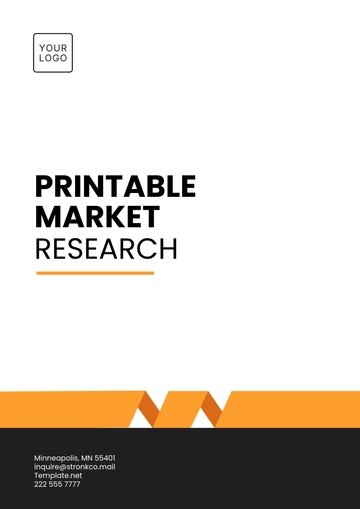Qualitative Market Research
I. Introduction
In 2055, the market landscape for [YOUR COMPANY NAME] has evolved significantly, necessitating a deeper understanding of consumer behavior, preferences, and emerging trends. This qualitative market research aims to explore the motivations and perceptions of consumers regarding sustainable home technologies, focusing on smart appliances, energy-efficient solutions, and eco-friendly innovations.
A. Objectives
To understand consumer attitudes towards sustainable home technologies.
To identify key motivators and barriers to adoption.
To explore trends influencing purchasing decisions.
To gather insights into brand perception and competitive positioning.
B. Methodology
This research employs qualitative methods, including focus groups and in-depth interviews, to gain rich, detailed insights into consumer perspectives.
II. Research Design
A. Participants
Sample Size: 40 participants
Demographics: Ages 25-45, mixed gender, homeowners, residing in urban and suburban areas.
B. Data Collection Methods
Focus Groups: Conducted with groups of 8 participants each, facilitating discussions about experiences and attitudes towards eco-friendly technologies.
In-depth Interviews: One-on-one interviews with 10 selected participants to delve deeper into personal motivations and barriers.
C. Research Questions
What are consumers' perceptions of eco-friendly technologies?
What factors influence their decision to purchase sustainable products?
How do consumers perceive the [YOUR COMPANY NAME] brand compared to competitors?
III. Key Findings
A. Consumer Perceptions
Participants generally view sustainable home technologies as beneficial for both the environment and cost savings. However, perceptions vary based on awareness and personal values.
B. Motivators
Environmental Concerns: A strong desire to reduce carbon footprints and protect the environment.
Cost Savings: Long-term financial savings from reduced energy bills.
Technological Innovation: Interest in the latest tech advancements and smart home integration.
C. Barriers
High Initial Costs: Perception of high upfront costs deterring some potential buyers.
Lack of Awareness: Limited knowledge about available options and benefits.
Compatibility Issues: Concerns about integrating new technologies with existing systems.
D. Trends
E. Brand Perception
[YOUR COMPANY NAME] is generally perceived positively, with strengths in innovation and environmental commitment. However, there is room for improvement in raising awareness and addressing cost concerns.
IV. Data Analysis
A. Focus Group Insights
Theme | Positive Feedback | Negative Feedback |
|---|
Environmental Impact | "I love that it helps reduce my carbon footprint." | "I'm not sure how much of an impact it really has." |
Cost Savings | "I've saved a lot on my energy bills." | "The upfront cost is just too high." |
Technological Appeal | "It's fascinating how it all works together." | "Too complex for someone who's not tech-savvy." |
Brand Awareness | "I trust it for innovation." | "I wish more people knew about them." |
B. Interview Highlights
Chart 1: Consumer Motivators for Sustainable Technologies
Description of Motivators:
Environmental Concerns: Consumers are increasingly motivated by the desire to reduce their carbon footprints and contribute positively to the environment. This is the leading motivator, reflecting heightened awareness of climate change and sustainability issues.
Cost Savings: A significant number of participants are motivated by the potential for long-term savings on energy bills and maintenance costs. While the initial investment may be high, the promise of reduced expenses over time is a strong driver.
Technological Innovation: The appeal of cutting-edge technology and smart home integration is a key motivator for consumers interested in staying ahead of technological trends and enhancing their home’s functionality.
Health Benefits: Some consumers are drawn to sustainable technologies due to perceived health benefits, such as improved air quality and reduced exposure to harmful chemicals.
Social Influence: A smaller percentage of consumers are influenced by social factors, including peer recommendations and societal trends toward sustainability.
V. Recommendations
A. Increase Awareness
B. Address Cost Concerns
C. Enhance Brand Positioning
VI. Conclusion
The qualitative research conducted for [YOUR COMPANY NAME] in 2055 reveals a promising market landscape for sustainable home technologies. While consumers are motivated by environmental and financial benefits, challenges such as high costs and awareness must be addressed. By implementing targeted strategies and leveraging its strengths, the company can enhance its market position and drive the adoption of eco-friendly solutions.
VII. Appendices
Research Templates @ Template.net






























